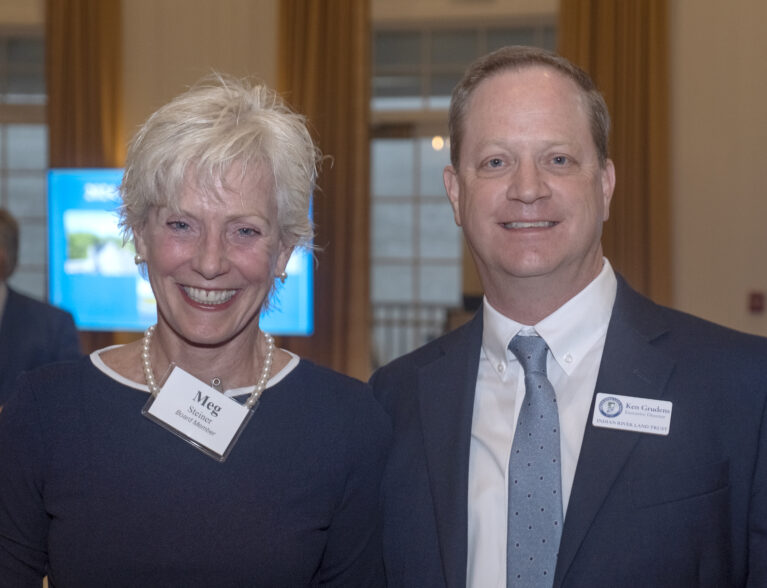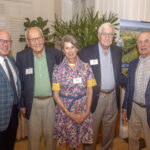
Environmental enthusiasts gathered at the Quail Valley River Club to celebrate the achievements of the Indian River Land Trust at its annual Conservators’ Reception, hosted by Sally and Dick Brickman.
“Back in 2013, Dick and Sally [Brickman], along with Laura and Bill Buck, held the first Conservators’ Reception,” said Meg Steiner, IRLT board chair.
“We lost both Bill and Laura this past year. The Bucks were amazing figures in the Vero Beach community with a strong passion for the lagoon. Bill was a transformative leader. This leadership was the catalyst that was needed to jumpstart the septic-to-sewer transformation.
He got that up and running, which will help improve the health of the lagoon,” said Steiner.
“The pressures of development are really going to change this county. It will impact the health of the lagoon, the wildlife, and the enjoyment that we have available to us. There’s work to do. We have a plan, but I’m asking you all to lean in and help us protect our lagoon,” she added.
IRLT executive director Ken Grudens shared that in 10 years, the number of Conservators has doubled, and their funding support has tripled.
“The Land Trust has protected 1,200 acres and 12 miles of shoreline. Those numbers are about to increase with the acquisition of another 48-acre piece of property on the Indian River Lagoon, and a piece that we’ve had in our sights for 15 years,” said Grudens.
That property, he noted, contains a quarter mile of lagoon frontage set within several parcels previously acquired by the Land Trust. “Once acquired, it will create a nearly 150-acre continuous block of permanently protected conservation land,” he said.
Referencing their 226-acre Coastal Oaks Preserve, one of their “true conservation gems,” Grudens said they will break ground on its Living Classroom this summer.
Doing so, he said, will enable them to partner with the Environmental Learning Center, Gifford Youth Achievement Center, Pelican Island Audubon, Vero Beach Museum of Art, Brevard Zoo and Harbor Branch Oceanographic Institute so as to immerse the public in unique research and education programs.
Additionally, dozens of interpretive signs have been installed along the trails of the Toni Robinson Waterfront Trail, named after the “mother” of the Land Trust.
“We will always preserve important wildlife habitat and restore it in the process. We will always protect our natural resources and waterways and provide public access for recreation, education and research,” said Grudens.
Grudens said the Land Trust has recently completed a computer-based strategic conservation planning tool to “identify and prioritize the protection of our state’s diminishing wildlife quarters, our pristine waterways, our drinking water recharge areas and important green space.”
Another critical acquisition will protect land along the St. Sebastian River, the “only natural tributary of the Indian River Lagoon,” that he said is in an area slated for dense residential development.
“Our goal is to protect the entire stretch of this ancient cypress grove; cypress that stood long before Vero Beach existed. It’s pristine and old growth, and this project is slated to really make a difference for an entire greenway trail along that river,” said Grudens.
Since its founding in 1990, the Land Trust has made significant strides in safeguarding the ecological health and vitality of the lagoon and its surrounding areas through strategic land acquisitions, habitat restoration projects and educational initiatives.
For more information, visit irlt.org.
Photos by Joshua Kodis
- Meg Steiner and Ken Grudens
- Meg Steiner and Ken Grudens
- Natalie Grudens and Camille Broadbent
- JD Hart and Dave Fuss with Tommye and Rody Johnson
- David Smith, Loreto Murray and Tim Glover
- Ingrid Caruso and John Christian
- Kathleen O’Brien Joachim and Philip Joachim with Linda Beardslee
- David Mike and Linda Van Name
- Jim Sullivan with Scott and Gail Alexander and Jerry Babicka
- Mike and Joan Hoben
- Anne Lanier, Camille Broadbent and Paula Knier
- Jeff Pickering, Don Riefler, Dace Stubbs, Kit Barrow and King Stubbs
- Joan Matthews with Lee and Susan Jennings
- Jim and Terry Byrnes with Melissa DePriest
- George Higgs and Stephanie Smith
- Monika Borgers with Katharine and Rohit Desai



















